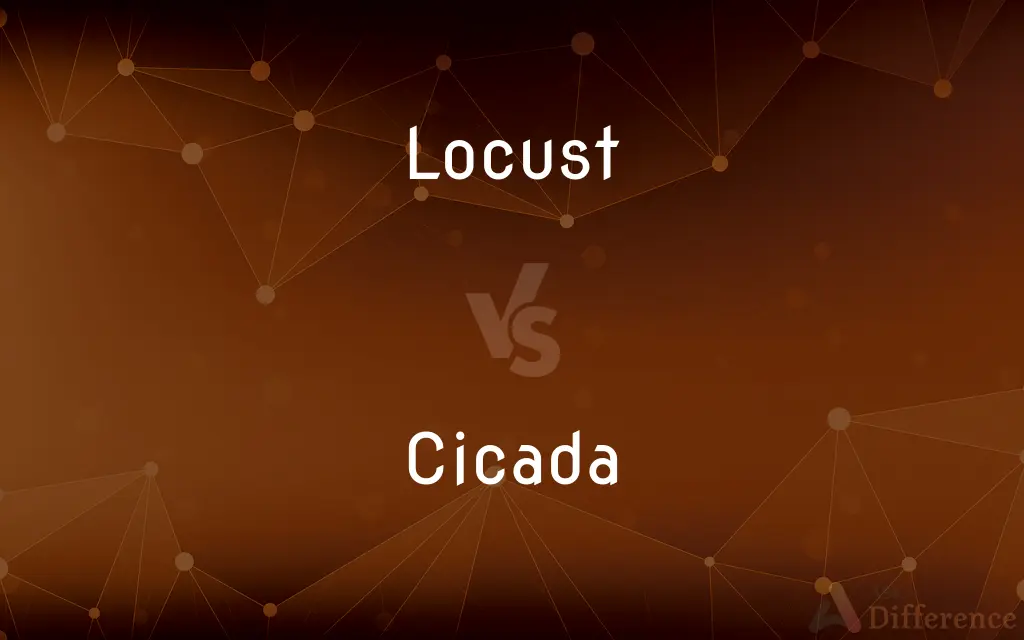Locust vs. Cicada — What's the Difference?
By Tayyaba Rehman — Updated on September 26, 2023
Locusts are grasshopper species causing massive agricultural damage; cicadas are harmless insects known for their periodic emergences and loud songs."

Difference Between Locust and Cicada
Table of Contents
ADVERTISEMENT
Key Differences
Locusts and cicadas are distinct insects, both contributing uniquely to their respective ecosystems. A locust is essentially a grasshopper but with the capability to change its behavior and habits in different environmental conditions, often known for swarming and causing significant agricultural damage. This insect is synonymous with devastation due to its potential to obliterate vegetation rapidly, impacting both ecosystems and human livelihoods. Conversely, a cicada is a benign insect, recognized for its distinct life cycle and the loud songs produced by males. Cicadas do not pose threats to agriculture and are more famous for their intriguing life cycles and the phenomenon of periodical emergences, where they surface in intervals, such as every 13 or 17 years, in large numbers.
The difference between locusts and cicadas is paramount, as one represents a threat to agriculture, while the other symbolizes fascinating biological rhythms and is generally harmless. A locust, with its ability to form massive swarms, can decimate vast areas of vegetation, posing substantial challenges to farming communities and necessitating effective control measures. In contrast, cicadas, with their unique life cycles and emergences, prompt interest and study in the fields of entomology and ecology, allowing scientists to explore complex biological patterns and environmental interactions.
The terminologies "locust" and "cicada" are integral in biological classifications, enabling precise identification and study of these insects. While locusts are studied primarily for developing control measures and understanding their impact on ecosystems, cicadas are studied for their unique life cycles and behaviors, offering insights into insect evolution, development, and environmental adaptations. Using these terms accurately is crucial for clear communication in scientific discussions, ecological studies, and environmental education.
In cultural and symbolic contexts, locusts and cicadas represent contrasting themes. Locusts are often symbolized as harbingers of destruction due to their swarming and devastating effects on vegetation, influencing narratives and symbolisms in various cultures and religions. Cicadas, however, are symbols of renewal and transformation, their periodic emergences symbolizing rebirth and endurance. These symbolic representations reflect the perceptible characteristics and ecological roles of these insects, enriching cultural narratives and artistic expressions.
Comparison Chart
Ecological Role
Causes massive agricultural damage
Generally harmless to vegetation
ADVERTISEMENT
Behavior
Forms destructive swarms
Known for periodic emergences and loud songs
Symbolism
Represented as a symbol of destruction
Symbolizes renewal and transformation
Scientific Study Focus
Developed for control measures
Studied for unique life cycles and behaviors
Impact
Affects ecosystems and human livelihoods
Prompts scientific interest and cultural symbolism
Compare with Definitions
Locust
Known for causing massive agricultural damage.
A swarm of locusts can decimate acres of farmland in a short time.
Cicada
An insect known for its distinct life cycle.
The cicada is famous for emerging in large numbers after years underground.
Locust
A grasshopper species capable of swarming behavior.
The farmer was worried about a locust invasion damaging the crops.
Cicada
Recognized for the loud songs produced by males.
The sound of the cicada filled the summer air.
Locust
Synonymous with devastation due to rapid vegetation consumption.
The locust is often seen as a symbol of destruction in many cultures.
Cicada
Harmless to agriculture and poses no threat to vegetation.
Unlike locusts, cicadas do not cause damage to crops.
Locust
Necessitates effective control measures to protect agriculture.
The government implemented various control measures to curb the locust invasion.
Cicada
Symbolizes renewal and transformation in various cultures.
Many cultures see the cicada as a symbol of rebirth due to its unique life cycle.
Locust
Locusts (derived from the Vulgar Latin locusta, meaning grasshopper) are a group of certain species of short-horned grasshoppers in the family Acrididae that have a swarming phase. These insects are usually solitary, but under certain circumstances they become more abundant and change their behaviour and habits, becoming gregarious.
Cicada
Surfaces periodically, such as every 13 or 17 years.
The town was abuzz with the anticipated emergence of the 17-year cicada.
Locust
Any of various short-horned grasshoppers that sometimes migrate in immense swarms, devouring vegetation and crops.
Cicada
The cicadas ( or ) are a superfamily, the Cicadoidea, of insects in the order Hemiptera (true bugs). They are in the suborder Auchenorrhyncha, along with smaller jumping bugs such as leafhoppers and froghoppers.
Locust
A cicada, especially a periodical cicada.
Cicada
Any of various insects chiefly of the family Cicadidae, having a broad head, membranous wings, and in the male a pair of resonating organs that produce a characteristic high-pitched, droning sound.
Locust
Any of several trees of the pea family bearing long pods, especially the black locust, honey locust, and carob.
Cicada
Any of several insects in the superfamily Cicadoidea, with small eyes wide apart on the head and transparent well-veined wings.
Locust
The wood of any of these trees.
Cicada
The periodical cicada.
Locust
Any of the grasshoppers, often polyphenic and usually swarming, in the family Acrididae that are very destructive to crops and other vegetation, especially the migratory locust (Locusta migratoria).
Cicada
Any species of the genus Cicada or of the family Cicadidae. They are large hemipterous insects, with nearly transparent wings. The male makes a shrill sound by peculiar organs in the under side of the abdomen, consisting of a pair of stretched membranes, acted upon by powerful muscles. A noted American species (Cicada septendecim) is called the seventeen year locust. Another common species is the dogday cicada.
Locust
A fruit or pod of the carob tree.
Cicada
Stout-bodied insect with large membranous wings; male has drum-like organs for producing a high-pitched drone
Locust
Any of various often leguminous trees and shrubs, especially of the genera Robinia and Gleditsia; the locust tree.
Locust
A cicada.
Locust
A Mainlander.
Locust
(intransitive) To come in a swarm.
Locust
Any one of numerous species of long-winged, migratory, orthopterous insects, of the family Acrididæ, allied to the grasshoppers; esp., (Edipoda migratoria, syn. Pachytylus migratoria, and Acridium perigrinum, of Southern Europe, Asia, and Africa. In the United States the related species with similar habits are usually called grasshoppers. See Grasshopper.
Locust
The locust tree. See Locust Tree (definition, note, and phrases).
Locust
Migratory grasshoppers of warm regions having short antennae
Locust
Hardwood from any of various locust trees
Locust
Any of various hard-wooded trees of the family Leguminosae
Locust
Can change its behavior and habits under different environmental conditions.
The locust transformed its behavior due to the changes in environmental conditions.
Common Curiosities
Do locusts cause destruction to vegetation?
Yes, locusts can cause massive destruction to vegetation due to their swarming behavior.
Are cicadas harmful to agriculture?
No, cicadas are generally harmless to agriculture and do not pose threats to vegetation.
What is a locust?
A locust is a species of grasshopper known for swarming and causing significant agricultural damage.
Do locusts have the capability to change their behavior and habits?
Yes, locusts can change their behavior and habits in different environmental conditions.
What do cicadas symbolize in cultural contexts?
In cultural contexts, cicadas are symbols of renewal and transformation, representing themes of rebirth and endurance.
Is controlling locusts important for protecting agriculture?
Yes, controlling locusts is crucial to protect agriculture from significant damage and loss.
Why are cicadas studied by scientists?
Cicadas are studied for their unique life cycles, behaviors, and periodic emergences, offering insights into insect evolution and environmental adaptations.
Are locusts symbols of destruction in cultures and religions?
Yes, locusts are often symbolized as harbingers of destruction in various cultures and religions due to their devastating effects on vegetation.
Are cicadas' songs produced by both males and females?
No, the loud songs of cicadas are typically produced by males to attract females.
Are cicadas a subject of interest in entomology and ecology?
Yes, cicadas prompt interest and study in entomology and ecology due to their fascinating biological rhythms and environmental interactions.
Do locusts play a role in ecological balance?
While locusts can cause ecological imbalances due to their destructive nature, they also serve as a food source for various predators, playing a role in ecological food chains.
What is a cicada known for?
A cicada is known for its distinct life cycle, periodic emergences, and the loud songs produced by males.
Can locusts affect human livelihoods?
Yes, locusts can significantly impact human livelihoods by destroying crops and vegetation, leading to food shortages.
Share Your Discovery

Previous Comparison
Rose vs. Sunflower
Next Comparison
Bowrider vs. RunaboutAuthor Spotlight
Written by
Tayyaba RehmanTayyaba Rehman is a distinguished writer, currently serving as a primary contributor to askdifference.com. As a researcher in semantics and etymology, Tayyaba's passion for the complexity of languages and their distinctions has found a perfect home on the platform. Tayyaba delves into the intricacies of language, distinguishing between commonly confused words and phrases, thereby providing clarity for readers worldwide.















































